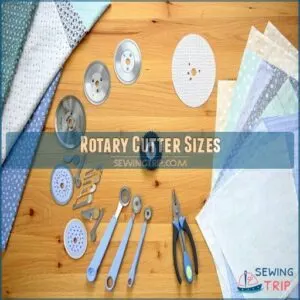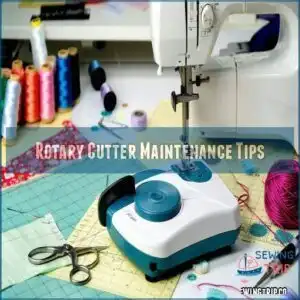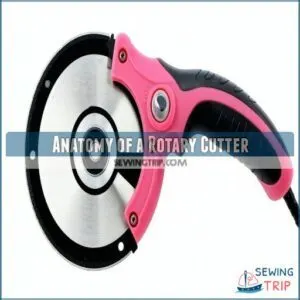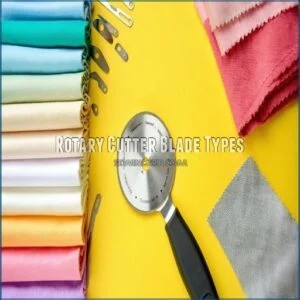This site is supported by our readers. We may earn a commission, at no cost to you, if you purchase through links.
 Looking for the best rotary cutter for fabric? You’ll want a tool that slices through material like a hot knife through butter!
Looking for the best rotary cutter for fabric? You’ll want a tool that slices through material like a hot knife through butter!
Whether you’re quilting, sewing, or crafting, the right rotary cutter can transform your project’s precision.
Size matters – from compact 18mm to robust 60mm blades – so choose based on your fabric thickness and project needs.
Titanium-coated blades offer durability, while ergonomic handles prevent hand fatigue.
Safety’s key: always use a self-healing mat and keep fingers clear of the cutting edge.
Pro tip: sharp blades aren’t just efficient – they’re safer too, ensuring safety and efficiency.
Your perfect cutting companion is waiting to elevate your fabric game.
Table Of Contents
- Key Takeaways
- What is a Rotary Cutter
- Rotary Cutter Sizes
- Choosing The Right Rotary Cutter for Fabric
- Safety Features to Look for in a Rotary Cutter
- Rotary Cutter Maintenance Tips
- Accessories for Rotary Cutters
- Anatomy of a Rotary Cutter
- Top 7 Best Rotary Cutters for Fabric
- Rotary Cutter Blade Types
- Tips for Using a Rotary Cutter for Fabric
- Frequently Asked Questions (FAQs)
- Conclusion
Key Takeaways
- You’ll want a 45mm rotary cutter as your versatile, all-purpose tool – it’s the Swiss Army knife of fabric cutting that handles most projects with precision and ease.
- Safety matters most: Always use a self-healing cutting mat, protect your fingers by keeping them away from the blade’s edge, and invest in a rotary cutter with a reliable blade guard.
- Your blade’s sharpness is crucial – a sharp blade not only cuts more efficiently but also reduces the risk of accidents and ensures clean, professional-looking cuts through multiple fabric layers.
- Consider your crafting needs when choosing a rotary cutter, looking at factors such as blade size, ergonomic handle design, and compatibility with different fabric types and thicknesses.
What is a Rotary Cutter
A rotary cutter is your go-to crafting tool for making precise, clean cuts through fabric, paper, and other materials with incredible ease.
Whether you’re quilting, sewing, or working on a DIY project, this handy tool will slice through multiple fabric layers faster and more accurately than traditional scissors.
Rotary Cutter Definition
Since crafting began, fabric enthusiasts have dreamed of the perfect cutting tool.
A rotary cutter is your precision partner in creative projects, designed to slice through fabric like a hot knife through butter.
Here’s why you’ll love it:
- Razor-sharp blades for clean cuts
- Ergonomic handle reducing hand strain
- Versatility across multiple fabric types
Your crafting game just leveled up.
Rotary Cutter Uses
The versatility of rotary cutters transforms crafting landscapes, empowering creators to slice through multiple materials with precision.
Whether you’re quilting, sewing, or diving into paper crafts, these tools are your creative sidekick.
When choosing the perfect rotary cutter, consider factors like the safest rotary cutters’ blade diameter and material, which can markedly impact your crafting experience.
| Craft Type | Materials | Cutting Precision |
|---|---|---|
| Quilting | Fabric layers | High |
| Sewing | Textile patterns | Moderate |
| Papercrafting | Paper, cardstock | Detailed |
| Vinyl Work | Decorative materials | Clean |
| Scrapbooking | Mixed media | Intricate |
Your crafting potential just got a serious upgrade.
Rotary Cutter Benefits
Revealing fabric cutting magic starts with your trusty rotary cutter.
You’ll slice through layers like a ninja, saving time and boosting accuracy in your crafting journey.
Whether you’re quilting, sewing, or creating intricate designs, this tool becomes your creative sidekick.
Its precision cuts mean less fabric waste and more confidence in your projects, turning potential frustration into pure crafting joy.
Rotary Cutter Sizes
Choosing the right rotary cutter size can make or break your fabric cutting experience.
So it’s critical to understand the differences between blade dimensions.
Whether you’re a quilting novice or a seasoned sewing pro, knowing which size works best for your project will help you slice through fabric with precision and ease.
18mm Rotary Cutter
Slice through delicate fabric details with an 18mm rotary cutter, your secret weapon for intricate cutting techniques.
Perfect for quilters and crafters craving precision, this compact blade navigates tight curves and narrow spaces like a pro.
When you need surgical accuracy in your fabric trimming, this tiny titan delivers maximum control with minimal effort, making complex projects feel like a breeze.
28mm Rotary Cutter
Moving from tiny 18mm blades, crafters find the 28mm rotary cutter a nimble companion for precision work. Perfect for intricate projects, this compact cutting marvel offers unparalleled control and maneuverability.
- Ideal for delicate fabric cuts
- Navigates tight curves effortlessly
- Lightweight and easy to handle
- Minimizes fabric distortion
When you’re ready to slice through patterns with surgical accuracy, the 28mm rotary cutter becomes your go-to crafting sidekick, transforming complicated cuts into smooth, effortless movements.
45mm Rotary Cutter
The fabric crafter’s Swiss Army knife, the 45mm rotary cutter reigns supreme in versatility and precision.
Perfect for quilters and sewists, this blade size strikes gold between intricate work and speedy cutting.
| Pros | Cons | Best For |
|---|---|---|
| Versatile | Requires maintenance | Quilting |
| Precise cuts | Blade replacement | Fabric crafts |
| Comfortable grip | Higher cost | Professional sewing |
Most crafters consider the 45mm their go-to companion for transforming fabric dreams into reality.
60mm Rotary Cutter
Ready to level up from the trusty 45mm?
Grab a 60mm rotary cutter when you’re tackling thick fabrics or multiple layers that need serious cutting power.
These heavyweight champions slice through upholstery, denim, and quilting projects like a hot knife through butter.
Perfect for professionals and DIY warriors who want speed, precision, and less hand fatigue during marathon crafting sessions, seeking serious cutting power.
Choosing The Right Rotary Cutter for Fabric
When you’re ready to slice through fabric like a pro, choosing the right rotary cutter can make all the difference in your crafting journey.
Your perfect cutting companion depends on factors like fabric thickness, project type, and the precision you’ll need, so let’s help you find the tool that’ll turn your sewing dreams into crisp, clean reality, with the right rotary cutter and perfect cutting companion.
Consider Fabric Thickness
Fabric weight isn’t just a number—it’s your cutting strategy’s secret weapon.
When choosing a rotary cutter, thicker fabrics demand larger blades like the 60mm Fiskars, while delicate materials sing with precision 28mm cutters.
Your blade size directly impacts cutting efficiency, whether you’re slicing through denim or dancing with chiffon.
Matching blade to fabric weight guarantees clean, effortless cuts every time.
Consider Project Type
When diving into your crafting adventure, the project type can make or break your rotary cutter choice.
Quilting requires precision, while home decor might demand tougher blades.
Embroidery projects need delicate handling, and garment making calls for versatility.
Your dream tool depends on the intricate dance between your creative vision and the material’s unique personality.
Your rotary cutter choice ultimately depends on finding the perfect balance between your project needs and the tool’s capabilities, but this balance is rooted in the intricate dance between your creative vision and the material’s unique personality.
General Blade for All-purpose Fabric Cutting
Because versatility matters in crafting, a 45mm rotary cutter is your go-to for conquering most fabric cutting challenges.
This workhorse blade slices through multiple fabric layers like a hot knife through butter, giving you precision and power for quilting, sewing, and general crafting projects.
It’s the Swiss Army knife of rotary cutters – reliable, adaptable, and ready to tackle your creative vision.
Smaller Blade for Precise Work
Want razor-sharp precision in your fabric cutting?
Smaller 28mm rotary cutters are your secret weapon for intricate work. After mastering all-purpose cutting, these mini magic wands let you tackle delicate curves, tight corners, and complex patterns like a pro.
Perfect for quilting details, appliqué work, and those tiny design elements that make your project pop.
Safety Features to Look for in a Rotary Cutter
When working with rotary cutters, your safety should always be the top priority to prevent potential injuries.
Learn how choosing the right safety features can transform your crafting experience from risky to reliable.
Retract Blade When Not in Use
Your rotary cutter’s blade guard is your first line of defense against unexpected slips and potential injuries.
Always engage the retractable blade mechanism the moment you set down your tool, creating a protective shield that keeps sharp edges safely tucked away.
This quick habit prevents accidental cuts and extends your blade’s lifespan, making your crafting experience both safer and smoother.
Cut Away From Yourself
A sharp blade’s trajectory can spell trouble if you’re not careful.
When using a rotary cutter, always slice away from your body to prevent accidental slips that could lead to serious injuries.
Keep your fingers clear of the cutting path, maintaining a safe distance between your hands and the blade’s razor-sharp edge.
Ensure Comfortable Reach
After steering clear of potential mishaps, zeroing in on your rotary cutter’s handle becomes a game-changer.
Ergonomic handles with adjustable lengths let you customize your grip, matching your body’s natural cutting posture.
Also, consider a handle with thumb indentations molded for a natural hold, as seen in rotary cutter safety.
Smart quilters know that comfort trumps everything – a well-positioned rotary cutter means less strain, more precision, and a smoother crafting experience that keeps you in the zone.
Use Safety Gloves
Almost every crafter knows accidents happen, but safety gloves are your secret weapon against rotary cutter mishaps.
These protective shields keep your fingers intact while you slice through fabric like a pro.
Here’s why you need them:
- Block accidental blade slips
- Provide cut-resistant protection
- Boost confidence during precise cutting
Don’t risk your digits – gear up and cut safely!
Rotary Cutter Maintenance Tips
Your rotary cutter is the heartbeat of your crafting arsenal, and keeping it in top shape isn’t just smart—it’s essential for precise cuts and project success.
Mastering a few maintenance tricks will help you extend your tool’s life, save money, and guarantee your fabric cuts stay razor-sharp every single time.
Clean Center and Replace With New Blade
Moving from safety to maintenance, cleaning your rotary cutter‘s center keeps it performing like a precision instrument.
To keep your rotary cutter in good condition, consider the rotary cutter blade options, such as standard blades or pinking blades, and their maintenance requirements.
Wiping away fabric lint and dust between projects prevents buildup that can compromise cutting performance.
Gently remove debris with a soft cloth, ensuring smooth blade rotation and protecting your investment in this crafting companion.
Sharp Blades Are Safer
A dull blade can turn your crafting dream into a safety nightmare.
Sharp rotary cutter blades slice through fabric like a hot knife through butter, reducing the force you need and minimizing accident risks.
When your blade starts feeling rough or requires more pressure, it’s time for a swap. Sharp blades mean precise cuts and safer crafting – your hands will thank you.
Quick-change Options Available From Olfa and Quilter’s Select
Need a blade swap that’s faster than a quilter’s heartbeat? Olfa and Quilter’s Select have you covered with lightning-quick blade changeover systems.
Their innovative designs let you swap rotary blades in seconds, saving precious crafting time.
These quick-change options mean less fumbling and more cutting, keeping your fabric projects flowing smoothly and your creativity uninterrupted.
Accessories for Rotary Cutters
When you’re serious about fabric crafting, the right rotary cutter accessories can make all the difference.
Between a frustrating project and a professional-looking finish, you’ll want to invest in quality.
Quality cutting mats, precise rulers, and replacement blades that’ll help you slice through fabric like a pro.
And keep your creative momentum going strong.
Cutting Mat to Protect Work Surface
A battle-worn cutting mat whispers stories of countless crafting adventures.
Protect your creative workspace with these essential strategies:
- Choose a self-healing mat that rebounds after each slice
- Invest in a high-quality mat sized for your typical projects
- Rotate your mat regularly to distribute wear evenly
- Store flat or hanging to prevent warping and maintain surface integrity
Your crafting sanctuary starts here.
Replacement Blades for Sharp Cutting
When your cutting mat starts showing wear, it’s time to stock up on replacement blades.
Sharp blades aren’t just a luxury—they’re your crafting lifeline. Swap out dull edges before they snag your fabric or compromise your precision.
Pro tip: Buy blades in bulk to save cash and keep your rotary cutter performing like a champ. Your projects will thank you.
Ruler for Straight Lines
After swapping out those razor-sharp blades, grab an acrylic ruler to keep your rotary cutting game razor-sharp.
These cutting-edge measuring tools are your secret weapon for blade alignment and straight-line accuracy.
Whether you’re quilting or crafting, a quality ruler helps you slice fabric with precision that’ll make your projects look professionally polished.
Pattern Master for Precise Measurements
Ready to level up your cutting precision?
A Pattern Master is your secret weapon for nailing those tricky measurements.
While rulers are great, this specialized tool helps you align fabric with laser-sharp accuracy.
Its gridded surface and clear markings make squaring up fabric a breeze, giving you that professional-grade cut every quilter and sewist dreams about.
Anatomy of a Rotary Cutter
Understanding your rotary cutter’s anatomy is key to mastering precise fabric cutting and ensuring your safety.
You’ll want to familiarize yourself with its essential components: the blade guard that protects you, the razor-sharp blade that slices through fabric, and the ergonomic handle that gives you control and comfort.
Blade Guard for Safety
Building on your cutting mat’s protection, let’s talk blade guards – your rotary cutter’s personal bodyguard.
These safety heroes complement the ergonomic handle, which reduces hand fatigue and increases efficiency, with over 40% of rotary cutter users reporting reduced hand strain. These safety heroes keep your fingers far from danger’s edge while you slice through fabric like a pro.
- Guarded blade technology prevents accidental slips
- Automatic blade locks engage when not in use
- Retractable shields mean safer storage
- Dual-action safety mechanisms provide extra peace of mind
Stay sharp, stay safe – your crafting adventure depends on it!
Sharp Blade for Cutting
Protecting your blade’s razor-sharp edge means understanding its cutting power.
Your rotary cutter’s blade slices through multiple fabric layers like a hot knife through butter, making precision cuts a breeze.
High-quality blades—whether titanium-coated or stainless steel—determine how cleanly and effortlessly you’ll glide through different fabric weights and textures.
Handle for Operation
Slice through fabric like a pro with a handle that’s your cutting companion. An ergonomic grip transforms your rotary cutter from a tool to an extension of your crafting prowess.
Master precision with these handle essentials, and consider investing in Ergonomic Rotary Cutters for the best results.
- Contoured design that hugs your hand’s natural curve
- Slip-resistant texture preventing mid-cut mishaps
- Lightweight materials reducing hand fatigue during marathon crafting sessions
Top 7 Best Rotary Cutters for Fabric
If you’re serious about cutting fabric like a pro, you’ll want to invest in a high-quality rotary cutter that’ll make your crafting projects a breeze.
Whether you’re a quilting enthusiast or a DIY fashion designer, these seven rotary cutters will slice through fabric with precision and ease, helping you create crisp, clean cuts every single time.
They will make your crafting projects a breeze.
1. Titanium Rotary Fabric Cutting Tool
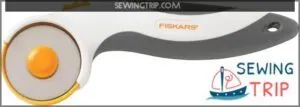
Your titanium-powered fabric cutting companion is a game-changer for crafters and sewists seeking precision and durability.
This 45mm rotary cutter boasts a titanium carbide blade three times harder than steel, slicing through multiple fabric layers like a hot knife through butter.
Its ergonomically sculpted handle provides comfort and control, while the sliding safety button guarantees secure blade storage.
Whether you’re quilting, crafting, or tackling intricate projects, this tool delivers professional-grade cutting with minimal effort and maximum reliability.
Best For: Sewists, quilters, and crafters who need a professional-grade, durable rotary cutter for precise cutting of multiple fabric layers and thicker materials.
- Three times harder than steel, ensuring exceptional blade durability and long-lasting sharpness
- Ergonomically designed handle provides superior comfort and control during cutting projects
- Sliding safety button offers secure blade extension, locking, and retraction for safe handling
- Higher price point compared to standard rotary cutters due to premium titanium carbide construction
- Specialized design might be overwhelming for casual hobbyists or beginners
- Limited to fabric and craft materials, not suitable for heavy-duty industrial cutting tasks
2. Martelli Ergo Rotary Cutter 60mm
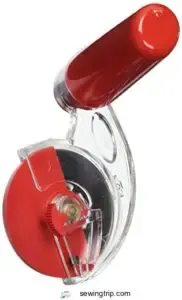
If you’ve battled hand pain during crafting, the Martelli Ergo Rotary Cutter 60mm might just be your new best friend.
Engineered with an innovative offset handle, this cutter delivers serious relief for folks struggling with arthritis or repetitive strain injuries.
Its ergonomic design reduces wrist stress while letting you glide through fabric layers like a hot knife through butter.
With razor-sharp blades and a comfortable grip, you’ll cut with precision and minimal discomfort, making your crafting sessions both enjoyable and effortless.
Best For: Crafters with arthritis, hand pain, or repetitive strain injuries who need a comfortable and precise rotary cutting tool.
- Ergonomic offset handle reduces wrist strain and minimizes hand discomfort during cutting
- Razor-sharp blades effortlessly cut through multiple fabric layers with exceptional precision
- Specifically designed to provide relief for users with hand mobility challenges
- Only compatible with Martelli-specific blades, limiting replacement options
- Right-hand model only, excluding left-handed users
- Potential safety concerns with blade exposure and lack of comprehensive spring-loaded cover
3. Olfa Rotary Cutter Tool Set
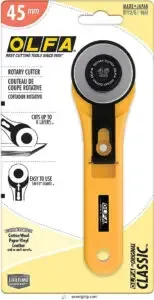
Someone serious about precision crafting will love the Olfa Rotary Cutter Tool Set.
This versatile kit transforms your fabric cutting game with its 45mm titanium blade that glides through multiple layers like a hot knife through butter.
Designed for both left and right-handed users, it offers comfortable ergonomics and exceptional control.
With an easy blade lock and durable metal construction, you’ll slice through fabric, tulle, and paper with professional-grade confidence.
It’s the ultimate companion for quilters and crafters seeking razor-sharp accuracy and is a great tool for those who take their fabric cutting game seriously.
Best For: Serious crafters, quilters, and sewists who need a precise, ergonomic tool for cutting multiple layers of fabric with professional-grade accuracy.
- Versatile design that works comfortably for both left and right-handed users, with an easy blade lock and durable metal construction.
- Sharp 45mm titanium blade that cuts through multiple fabric layers effortlessly and maintains its edge after 100 cuts.
- Suitable for a wide range of projects including quilting, sewing, upholstery, and crafting with clean, straight edge results.
- Requires a separate cutting pad or board for safe use, adding to the overall project setup cost.
- Replacement blades can be more expensive compared to generic alternatives.
- Sharp blade necessitates careful handling, which may be challenging for less experienced crafters or younger users.
4. Electric Fabric Rotary Cutting Machine
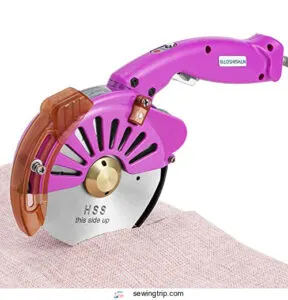
A powerhouse of fabric cutting, the Electric Fabric Rotary Cutting Machine transforms your crafting game.
Designed for makers who crave efficiency, this machine slices through 10-20 layers of fabric like a hot knife through butter.
With five adjustable speed gears and three smooth-rolling base wheels, you’ll zip through 100+ fabric pieces in just five minutes.
Perfect for serious sewists and small production teams, it’s your ticket to cutting mastery.
Best For: Serious crafters, small-scale production teams, and professional sewists who need to cut multiple fabric layers quickly and efficiently.
- Cuts up to 20 layers of fabric simultaneously, drastically reducing cutting time for large projects.
- Ergonomic design with adjustable speed and smooth-rolling base provides comfortable and versatile usage.
- Includes safety features like a protective plastic shell and built-in whetstone for blade maintenance.
- Corded design may limit mobility and flexibility in workspace setup.
- Not ideal for intricate or detailed cutting work, best suited for straight-line fabric cuts.
- May be overkill for hobbyists or occasional sewers due to its professional-grade capabilities.
5. Fiskars Contour Rotary Cutting Tool
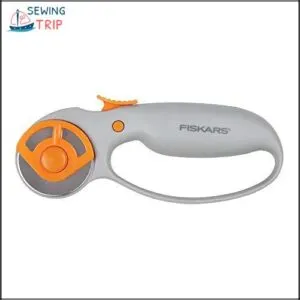
The Fiskars Contour Rotary Cutting Tool emerges as a game-changer for crafters seeking precision and comfort.
Designed with titanium carbide blades, it accommodates both right- and left-handed users, making it a versatile companion in your crafting arsenal.
Its ergonomic handle reduces hand fatigue, while the sliding safety lock keeps you protected during intricate cutting projects.
Whether you’re quilting, sewing, or tackling detailed fabric work, this tool promises smooth, effortless cuts that’ll enhance your creative process.
Best For: Quilters, crafters, and individuals with hand or finger limitations seeking a comfortable and safe rotary cutting tool.
- Ergonomic curved design reduces hand fatigue and provides excellent control
- Sliding safety lock and blade retraction feature enhances user protection
- Versatile tool suitable for cutting multiple layers of fabric, paper, felt, and vinyl
- Blades may require frequent replacement with heavy use
- Not recommended for cutting hard materials like foam core board
- Some users have reported concerns about blade longevity
6. Arteza Double Sided Quilting Ruler Set
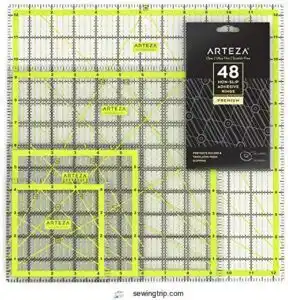
Step up your quilting game with the ARTEZA Double Sided Quilting Ruler Set – a game-changer for precision crafters!
Packed with four laser-cut acrylic rulers in versatile sizes, these yellow and black beauties feature patented two-color grid lines that make cutting a breeze.
Whether you’re a beginner or a seasoned pro, these sturdy rulers offer accurate measurements and a 1/2" seam allowance.
Fluorescent markings and multiple sizes guarantee you’ll nail every cut with confidence, making your crafting journey smoother than ever.
Best For: Quilters, sewers, and crafters of all skill levels looking for accurate, versatile, and affordable measuring tools.
- Laser-cut acrylic rulers in four different sizes provide maximum flexibility for various project needs
- Patented two-color grid lines with fluorescent markings make measuring and cutting super easy on both light and dark fabrics
- Durable construction with 0.1" thick acrylic and precise 1/2" seam allowance ensures professional-quality results
- Some users reported minor packaging issues like corner chipping
- Additional ruler included might not meet everyone’s specific needs
- Yellow and black color scheme may not appeal to all aesthetic preferences
7. Fiskars Self Healing Cutting Mat
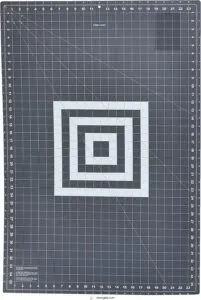
Protecting your workspace like a quilting ninja, the Fiskars Self Healing Cutting Mat offers serious crafters a durable surface that’s built to withstand countless cuts.
Measuring 36" x 24", this extra-large mat gives you plenty of room to spread out your projects.
With easy-to-read measuring grids and bias lines at 30, 45, and 60 degrees, you’ll nail precise cuts every time.
You can find this Fiskars cutting mat and other similar products on a dedicated website for Fiskars cutting supplies.
Though not as "squishy" as some mats, it’s a solid, budget-friendly option that’ll keep your surfaces safe and your creativity flowing.
Best For: Crafters, quilters, and DIY enthusiasts who need a large, versatile cutting surface for precise project work.
- Extra-large 36" x 24" size provides ample workspace for multiple projects
- Includes helpful measuring grids and angle lines for accurate cutting
- Durable construction protects work surfaces and withstands repeated use
- Not as soft or self-healing compared to some premium cutting mats
- May not be as forgiving on blade edges during extended use
- Might be too large for smaller crafting spaces or compact workstations
Rotary Cutter Blade Types
When you’re serious about fabric cutting, understanding blade types isn’t just technical know-how—it’s your secret weapon for precision and efficiency.
You’ll want to explore high-speed steel, titanium-coated, and specialty blades that can transform your crafting experience from basic to brilliant.
High-speed Steel Blades
Keen crafters know high-speed steel blades pack a punch for rotary cutter performance.
These workhorse blades slice through fabric like a hot knife, delivering precision cuts that’ll make your quilting projects sing.
They’re budget-friendly and reliable, offering sharp edges that keep your cutting game strong without breaking the bank.
Just replace ’em regularly to maintain stellar cutting power.
Titanium Coated Blades
When crafting precision cuts, titanium-coated blades are your secret weapon in the fabric-cutting arsenal.
These high-performance blades boast incredible edge retention and resist wear like a champ.
You’ll love how they slice through multiple fabric layers with razor-sharp precision, making your quilting and crafting projects smoother than ever.
Their durability means fewer blade replacements and more creative time.
Specialty Blades
Blade mavens, specialty rotary cutter blades are your secret weapon for precision crafting.
Release your creative potential with these game-changing tools that transform ordinary cutting into an art form:
- Wave blades slice fabric with dramatic, decorative edges
- Pinking blades prevent fabric fraying like magic
- Curved blades navigate intricate patterns effortlessly
- Endurance blades cut through multiple layers without breaking a sweat
Elevate your crafting game with these revolutionary cutting companions!
Tips for Using a Rotary Cutter for Fabric
For fabric cutting, your rotary cutter can be a game-changer if you know how to use it right.
Mastering a few key techniques will help you slice through fabrics like a pro, keeping your projects precise and your fingers safe.
Use a Self-healing Mat for Protection
Protect your work surfaces with a self-healing cutting mat – it’s like a superhero shield for your crafting space. These mats aren’t just protection; they’re your quilting companion.
When choosing the perfect mat, consider the importance of a clean and well-lit workspace, as emphasized in fabric cutting tips for beginners.
| Feature | Benefit |
|---|---|
| Self-healing Surface | Prevents blade damage |
| Multiple Sizes | Fits any project |
| Grid Lines | Guarantees precision cuts |
Your fabric deserves a pristine cutting experience that saves your blades and work area from unnecessary wear and tear.
Keep Fingers Away From Ruler’s Cutting Edge
After protecting your work surface with a self-healing mat, mastering ruler safety becomes your next quilting superpower.
For more information on safe rotary cutter practices, check out these helpful resources on rotary cutter safety. Keeping fingers far from the cutting edge prevents painful mishaps and keeps your crafting dreams intact.
Here’s how to stay safe:
- Position fingers behind the ruler’s edge
- Use ruler grips for stability
- Maintain consistent pressure
- Move slowly and deliberately
Steady hands save skin!
Ensure Proper Blade Tension
When your ruler starts sliding or your cuts feel uneven, you’ll know it’s time to check your rotary cutter’s blade tension.
Twist that tension knob until the blade feels snug but not too tight—think of it like tuning a guitar string.
A perfectly calibrated blade glides through fabric like a hot knife through butter, giving you clean, precise cuts every single time.
Frequently Asked Questions (FAQs)
What is a good rotary cutter for fabric?
The Olfa 45mm Deluxe Rotary Cutter is your fabric-cutting champion.
Its ergonomic design and titanium blade slice through multiple fabric layers with precision, making quilting and sewing projects a breeze for both newbies and seasoned crafters.
What is the best tool for cutting fabric?
Slice through fabric like a hot knife through butter with a 45mm rotary cutter.
You’ll find the Olfa Deluxe Ergonomic model offers precision, comfort, and durability – making your cutting projects smoother than ever before.
How many layers of fabric can you cut with a rotary cutter?
Most rotary cutters can slice through 4-6 layers of fabric smoothly, depending on blade sharpness and material thickness.
Pro tip: Use a fresh, high-quality blade and a self-healing mat for clean, precise cuts every time.
What is the difference between a 45mm and 60mm rotary cutter?
Just like choosing between a Swiss Army knife and a machete, your rotary cutter size matters.
A 45mm blade is your versatile go-to for most projects, while a 60mm tackles thick fabrics and multiple layers with brute force.
What size rotary cutter is best for fabric?
You’ll find the 45mm rotary cutter is your sweet spot for fabric.
It’s versatile enough to handle most cutting tasks, from quilting to garment making, while offering precision and comfort without overwhelming your hand.
Are rotary cutters good for cutting fabric?
Like a sharp-edged superhero slicing through fabric challenges, rotary cutters are fabric-cutting champions.
They’ll glide effortlessly through multiple layers, offering precise cuts, ergonomic comfort, and unmatched versatility for quilters, sewists, and crafting enthusiasts.
What is best for cutting fabric?
For precise fabric cutting, grab a 45mm rotary cutter with titanium blades.
Olfa and Fiskars reign supreme, offering ergonomic designs that slice through multiple fabric layers effortlessly.
This makes your crafting projects smoother and more professional.
How many layers of fabric can a rotary cutter cut through?
Wondering how much fabric your rotary cutter can slice through?
Most quality rotary cutters easily cut 3-6 layers simultaneously, depending on fabric thickness and blade sharpness.
Choose the right blade, and you’ll power through your project effortlessly.
What is the best rotary cutter for fabric?
You’ll love the Olfa 45mm Deluxe Ergonomic Rotary Cutter for its precision and comfort.
It cuts through multiple fabric layers effortlessly, offers superior control, and fits perfectly in your hand, making quilting and crafting a breeze.
What are the best rotary cutter tools?
Ironically, slicing through fabric isn’t rocket science—
it’s about choosing the right rotary cutter.
Fiskars’ titanium-blade model and Olfa’s ergonomic design top the list,
offering precision, comfort, and durability that’ll make your crafting projects a breeze.
Conclusion
Ready to elevate your fabric crafting? With 62% of sewists reporting improved precision using the right rotary cutter, you’re just one tool away from game-changing results. Whether you’re a quilting newbie or seasoned pro, the best rotary cutter for fabric can transform your projects. Don’t settle for subpar cutting, invest in quality, prioritize safety, and watch your creativity soar.
Ready to elevate your fabric crafting. With 62% of sewists reporting improved precision using the right rotary cutter, you’re just one tool away from game-changing results. Whether you’re a quilting newbie or seasoned pro, the right rotary cutter for the best rotary cutter for
assistant
The text is right to elevate your fabric crafting.


